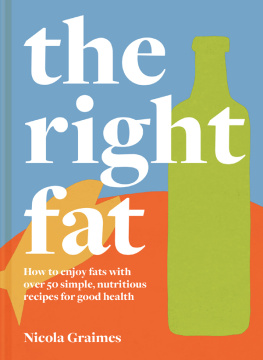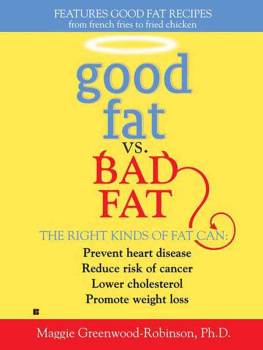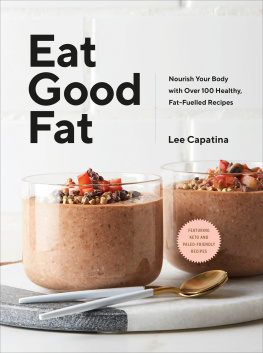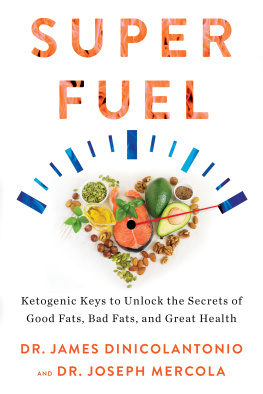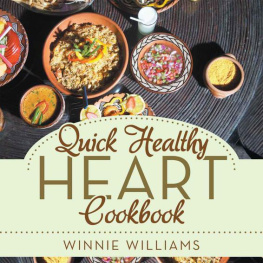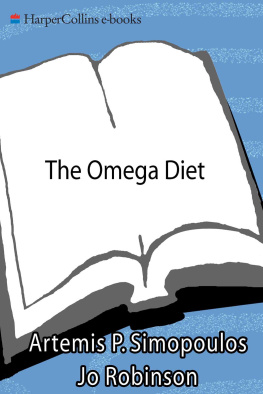Contents
Guide



Speaking up for Fat
Dietary fat is essential to good health, yet for many it comes with negative connotations. Over the years we have been told fat is bad and advised to switch to low-fat foods, including highly processed oils and hydrogenated margarines and spreads. But this dietary advice hasnt made us healthier and, if anything, has been detrimental to our well-being as obesity, heart disease and type 2 diabetes have exponentially increased. With so much misinformation and misunderstanding about fat, the time is right to stand up for this vital food group.
Not all fats are created equal. For many years saturated fat has been cast as the bad guy, linked with an increased risk of heart disease, but there is a growing body of evidence that questions this. If the saturated fat content is reduced to make a food low-fat, then what replaces it? The answer isnt good In one study, replacing fat with sugar and refined carbs actually increased the risk of a heart attack. We are better off avoiding processed low-fat foods in favour of fresh, minimally processed foods that provide a wide range of nutrients and health benefits, even if they do contain fat. These are the right fats.
This book focuses on the positive attributes of the right fats from the right foods an eclectic mix including extra virgin olive oil, nut and coconut oils, oily fish and other seafood, eggs, nuts, seeds, free-range poultry and, perhaps most controversially, meat and dairy, albeit from grass-fed, organically reared animals. It celebrates these ingredients, not only for their many health benefits, but also for the incredible diversity, taste and enjoyment they bring to our cooking and eating. Dont eat less fat or low fat, just eat the rightfats.

Do We Really Need Fat?
We need fat to survive. Fat is a crucial source of energy, vital for cell growth, hormone regulation, blood clotting, brain and cognitive development (our brain is two-thirds fat). Fat helps the body absorb certain minerals and fat-soluble vitamins, including A, D, E and K, which need fat to be absorbed. Fat also supports good heart, gut, eye, skin, bone and mental health.
Fat plays an important role in making food satisfying to eat and helping us feel fuller for longer. Despite fat providing more calories per gram than protein or carbohydrates, people who eat a good range of healthy fats have been found to lose more weight than those who follow low-fat diets, or diets based on refined carbs and fat. However, good health is not about looking at one food group in isolation but how fat works in tandem with other macronutrients, such as good-quality protein and unrefined carbs, to support our physical and mental well-being.
Fat the Basics
There are two types of fat: saturated and unsaturated; many foods are a combination of the two.
Saturated fatty acids (SFAs)include short-, medium- and long-chain fatty acids, all of which have different effects on health. Saturated fat is found mainly in animal products such as butter, whole milk, cream, cheese and meat as well as coconut oil and palm oil. It is solid at room temperature.
Unsaturated fatis made up of polyunsaturated and monounsaturated fat. It tends to be liquid at room temperature.
Monounsaturated fatty acids (MUFAs)are found in olive oil, avocados and most nuts, including almonds, cashews, Brazils, pistachios and peanuts. Monounsaturated fat, or omega-9, is a good source of beneficial antioxidants and vitamins E and K. It comes with a long list of health attributes and numerous studies link MUFAs with a reduced risk of many chronic diseases, including cancer, heart disease, type 2 diabetes, Alzheimers and arthritis.
Polyunsaturated fatty acids (PUFAs)form two main types, omega-3 and omega-6, with some foods offering both. These essential fatty acids (EFAs) have to be provided by the diet as they cannot be made by the body. It is important to eat a balance of omega-3 and omega-6, with many of us eating too much of the latter and not enough of the former. Scientists have linked this imbalance to an increase in inflammatory conditions, including heart disease, diabetes and obesity.
Omega-3 comprises EPA (eicosapentaenoic acid), DHA (docosahexaenoic acid) and ALA (alpha-linolenic acid). EPA and DHA come mainly from animal foods such as oily fish, oysters, clams, mussels and meat and dairy from grass-fed cows (see

